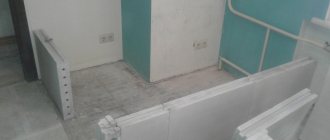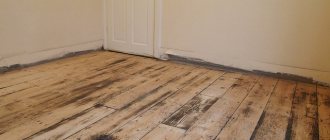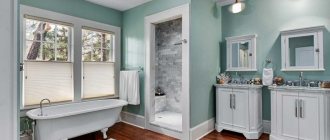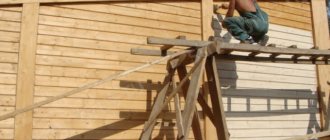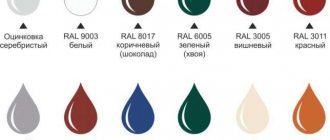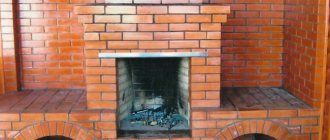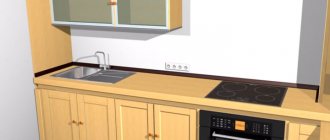The material was prepared with the participation of specialists
In recent years, OSB has been increasingly used for cladding facades in low-rise construction, but this complex material requires finishing. One of the most popular and most inexpensive ways to finish facades made of OSB and houses made of SIP panels is painting. It is believed that it is very difficult to paint oriented strand board, that this material literally repels paint, and a painted facade often causes many complaints. In this article, with the help of specialists, we will talk about the intricacies of painting a facade made of this material, what paint you need to choose for it and what to do so that it fits well and reliably protects the facade from external influences.
What are the advantages of painting?
The use of properly selected paints and varnishes will give the owners of a house lined with OSB boards the following advantages:
- less effort and time when compared with traditional wall decoration;
- the ability to mask the texture if it is created by large enough chips;
- protection from moisture – the surface does not suffer from deformation, because water does not penetrate inside.
Painting OSB for interior decoration is used only for interior decoration, because the outside of the slabs will experience serious influence from the environment. The base will require more serious protection. This should be remembered by everyone who is interested in how to paint OSB boards inside houses.
What features need to be considered when choosing paint for OSB
When choosing a paint coating for OSB, it is necessary to take into account certain features of this material.
Adhesion of paint and varnish coatings and OSB boards
Some paints adhere very poorly to the surface of the OSB board due to poor adhesion between the materials. This happens because OSB boards are initially impregnated with resins and do not absorb paint well. For painting OSB, it is not recommended to use water-based paint and other water-soluble compositions. It is necessary to give preference to acrylic or other polymer-based compositions.
OSB board texture
A special feature of this material is its pronounced texture. The surface of the slab is uneven and rough - this increases paint consumption and requires preliminary preparation before painting.
Age of OSB board
OSB boards that are not properly protected with coatings and have stood outside for more than one year are the worst to paint. Under the influence of ultraviolet radiation and humidity, the quality of the surface of the OSB board greatly deteriorates. Even paint specially designed for OSB boards does not adhere well to such surfaces. In this case, for high-quality painting, the surface must be cleaned of dirt, sanded and treated with antiseptics.
Preparation of material
Proper preparation greatly influences how high-quality the final coloring result will be. The more thorough the preparation, the higher the adhesion of the material and base to other surfaces. Then the decorative layer will last much longer.
There are several important rules:
- Painting can be done before installing the panels, if this is permissible. But this option negatively affects the appearance of the structure. Therefore, more often they still process the cladding, the installation of which has already been completed.
- Sanding is carefully carried out on the surface of the slabs. Standard sandpaper works fine. This will not only allow you to disguise the structure of the slab itself, but also get rid of the layer of protection that often prevents the primer from penetrating deeper.
The OSB-3 variety requires particularly careful grinding. The wax-varnish coating cannot be removed so easily.
Pre-processing is performed in the following sequence:
- We use putty to level the surface of any parts and places where screws are attached. An adhesive-oil base is the best choice.
- The seams between the slabs are sealed with an adhesive-oil mixture. But the boundaries often become visible and remain a little noticeable. Advice from experienced craftsmen is not to waste time trying to disguise the material, but simply hide the seams themselves with the help of decorative elements.
- When the putty dries, it must be sanded until the surface is perfectly smooth. How OSB can be covered is a separate question.
The priming process is as follows. Here's what you can use:
- The simplest option is water-based varnish for wooden surfaces. Acrylic or acrylic-polyurethane compositions are diluted using a ratio of 1:10. Then they are applied to the slabs until the impregnation is uniform.
- Alkyd varnish is one of the available alternatives. But for dilution they use not water, but white spirit or other similar means. Then the painted item will look better.
- A good alternative is the so-called adhesive primers. Such compositions help create high-quality surface protection from paint.
How to paint OSB board outdoors
If you choose paint for exterior use, make sure that it contains special additives that protect against ultraviolet radiation. Otherwise, under the influence of sunlight, the surface will quickly delaminate and require repainting.
When choosing how to paint an OSB board on the outside, you should give preference to polymer-based paints, which are recommended for coating wooden surfaces. They fit well on uneven surfaces and reliably protect the base from exposure to ultraviolet radiation and precipitation. Before applying a coat of paint, you should prepare the surface, level it and apply a primer. It is better to putty large holes and joints.
When applying paint, follow the manufacturer's instructions. Continuous painting in one color favorably highlights the expressive structure of OSB boards and prevents the penetration of moisture.
Suitable for painting external walls and facades:
Oil paints.
This is one of the best and most reliable options. They are quite viscous and poorly absorbed into the slab. This paint takes a long time to dry, but forms a durable protective layer with good performance characteristics.
Modern alkyd enamels and specialized alkyd-based paints for wood panels.
They penetrate deeply into the structure of the slab and last a long time. Walls painted with alkyd paints do not need to be coated with a protective varnish - this significantly reduces finishing costs.
Acrylic paints.
They cover unevenness well and allow you to achieve a uniform tone. If you treat the exterior walls with a mold-resistant primer, you can paint them with quality waterproof acrylic paints.
Professionals believe that the choice of material for painting OSB slabs outdoors is determined by the characteristics of the slab itself and its operating conditions. Modern waterproof polymer-based coatings better protect walls from moisture penetration and active ultraviolet radiation than water-based paints. At the same time, acrylic paints make it easy to wash and clean painted boards, and compositions based on latex, alkyd resins or polyurethane form a durable, impermeable film on the surface.
Puttying
If the interior decoration of structures based on an OSB board must be perfect, and painting is chosen as the finishing touch, applying a layer of putty is indispensable. Here you will also have to first apply a primer so that the putty composition fits better on the surface of the panel. Seams and joints are treated with sealant and covered with painting mesh or sickle tape.
On the main surface of the slabs, puttying is carried out using exactly the same technology as when working on any other base - concrete, wood or brick. If it is intended to apply a sufficiently thick layer of putty, it must be reinforced over the entire area with a polymer stack for reinforcement.
How to paint an OSB board inside a house
When choosing paint for interior decoration, it is necessary to take into account compliance with environmental requirements. Not all varnishes and polymer-based compositions can be called harmless to health.
If you are going to paint OSB boards indoors, you are better off with the following options:
Acrylic paint.
It is perfect for walls and floors inside the house. The surface is uniform in tone, leveled, with good coverage.
Stain + varnish
If you prefer the natural texture of OSB boards, use an idea popular among designers. They advise using stain or patina-effect compositions to give the desired shade, and then covering the surface of the slab with varnish, vinyl or polyurethane-based.
It is worth mentioning separately about such a variety of paints and varnishes as glazing azures. Glazing azures are transparent, thin paints that can give wood a certain shade and preserve its texture. Glazes can be produced on both acrylic and alkyd bases. Acrylic-based glazes, as a rule, can be used for both interior and exterior work, and alkyd-based glazes can only be used for exterior use.
Some manufacturers allow the use of glaze on OSB boards
When using these coatings for exterior finishing of OSB boards, pay attention to the ability of the coating to withstand UV rays. Taking into account the texture of OSB boards and the decorative capabilities of glaze paints, it is possible to obtain very attractive surfaces of various shades
Mosaic laying of square slabs in a checkerboard pattern will somewhat “revive” the floor surface
This option will allow you to create an original textured pattern of the floor covering and well disguise the joints between the slabs.
If the OSB has a color that satisfies the home owner, then the coating can simply be coated in several layers with varnish or epoxy, having previously cleaned the surface. If the shade is not completely satisfactory, it can be changed using stain or the technique suggested below.
However, it must be taken into account that the slabs will have to be cut into separate fragments, the edges of which must be perfectly smooth. In addition, this type of flooring will look aesthetically pleasing only on a perfectly flat base.
The third option for decorative painting of OSB
This method of painting slabs is accessible to anyone, even an inexperienced craftsman. The main thing in this process is to follow the instructions provided by the professionals.
Staining
Another way to design OSB is to treat it with stain. This is a composition that gives wood a tint, but does not create a film on its surface.
Treatment of OS boards with stain:
- Sand the surface with sandpaper, drill or grinder with a special wheel.
- Remove dust.
- If there are cracks, fill them with putty and sand them again.
- Apply the composition in 3 layers. The first and last along, the second across.
- After the last layer has dried, sand the surface of the slabs again with sandpaper or a wheel with the finest grain.
- Remove sanding dust.
Stains, like impregnations, protect the painted surface from rotting, moisture, and impart fire-retardant properties. The coating can be transparent, translucent, or completely opaque. There are stain varnishes on sale that combine the properties of both types of paints and varnishes. They simultaneously protect the surface, give a beautiful shade and create a glossy film.
Features of applying compositions to OSB boards with your own hands
Work is carried out in warm, dry, windless weather, preferably cloudy
Painting work begins in warm, windless weather, recommended air temperature is +10-25°C. It is advisable to avoid direct sunlight, which will lead to uneven drying. First of all, the composition is applied to the edges of the panels. These areas are characterized by the greatest absorption. Then the entire surface is evenly covered with paint. Movements with a brush (roller) are performed in one direction. It is recommended to apply a thin first coat and avoid wide overlap of stripes. After the paint has dried, a second layer is applied. If the expected result is not achieved, a third coat will be required.
There are several coloring options that can be used to finish the slabs.
Applying stain
The application of stain will allow you to emphasize the structure of the material, giving it a deeper shade. The composition is diluted with a solvent and applied with a spray gun. After drying, the surface is coated with polyurethane varnish.
Artificial aging
Artificial aging
To give the slabs a stylish decorative effect, special varnishes and patinas are used. The process is complex and consists of many stages:
- the surface of the plates is polished;
- a barrier primer is applied;
- the slab is coated with a white matte primer;
- the top layer of the coating is removed with a grinding wheel;
- the plate is treated with acrylic varnish in 2-3 layers;
- A black patina is applied to the OSB using a sprayer;
- The surface is polished to provide an aging effect.
The work takes a lot of time, it is necessary to take breaks and wait for each applied composition to dry. Artificial aging preserves the texture of OSB, but without noticeable chip protrusions.
Painting with primer paint
Facade primer-paints for OSB combine the properties of a finishing coating, primer and bioprotection. They have the necessary adhesion and good hiding power. They are applied to the textured surface of the slabs in two layers, in one the stripes are placed vertically, and in the second horizontally. The work is performed with a fur or foam roller, previously soaked in water. Before use, the primer paint is stirred until smooth. After drying, the result is an elastic, non-flammable and vapor-permeable coating with a service life of up to 10 years. The OSB texture does not show through it. The composition is sold in white, but there are thousands of color options.
Relief paint
Relief paint
To create a relief coating, silicone, latex or alkyd water-dispersed paints are used. Thick viscous compounds do not need to be diluted. They are applied to the primed surface with a wide spatula or roller. The layer should be 1.5-2 mm. The relief is created by mineral chips or filler fibers. The design is created manually by treating the surface with a dry roller. The intensity of pressure regulates the depth of the texture.
General characteristics of slabs
Technical characteristics of OSB boards
Materials with specific markers are suitable for each specific purpose. The installation technique depends on the structure of the product.
Among the main characteristics it is worth highlighting:
- Density. The indicator can vary from 640 to 700 kg/m³.
- Fire resistance level. Elevated marker. G4 involves treating the slabs with fire-resistant solutions.
- Paintability. Often such panels are coated with various types of varnish.
- Manufacturability. Susceptibility of the material to sawing, cutting, grinding and standardized installation.
- Swelling. The figure ranges from 10 to 22%.
- Fastener holding capacity. The fibrous texture ensures a strong hold even on the outer edge of the sheet. Fastening with self-tapping screws, nails and staples is allowed.
Manufacturers and prices
Finishing building materials
The most widely used chipboards on the market are those produced in Germany, Romania, Canada and Russia. The main brands with prices per 1 sheet are presented in the table:
| Brand name | Manufacturer country | Price for 1 sheet |
| Glunz | Germany | from 1200 rub. |
| Arbek | Canada | from 800 rub. |
| Norbord | Canada | from 1000 rub. |
| Egger | Romania | from 1000 rub. |
| Talion | Russia | from 500 rub. |
| Kronospan | Austria | from 550 rub. |
| Kalevala | Russia | from 600 rub. |
German sheets from Glünz are considered the highest quality (but also the most expensive); Canadian products have proven themselves well: Arbeck and Norbord. Among Russian-made building materials, OSB brands Kalevala and Talion are popular.
Types of paints for painting OSB boards on the facade
The modern building materials market offers many types of paint and varnish products. But not every paint can be suitable for painting an OSB board on a facade. What and how to paint correctly should be decided after a thorough acquaintance with the properties of paints and your financial capabilities. When choosing paints, you need to remember that oriented strand panels are 90 percent wood
This means that you should pay attention to the area of application and their properties first of all. Let's take a closer look at some types of paint and varnish products.
Alkyd
Alkyd paints for painting facades are most loved by finishers and home-grown builders. Such paints are perfectly absorbed into wood and dry quickly due to the water component. But this is associated with a small disadvantage of this paint. It needs to be stored only at above-zero temperatures, although in a hardened state it can withstand frost up to 30 degrees. Negative features also include low resistance to fire and alkalis. But despite this, paints of this class are popular due to:
- absence of unpleasant odor or harmful secretions;
- quick drying, retaining color for a long time, that is, they do not fade;
- excellent hiding power or the ability to create a flat, smooth surface without streaks;
- long service life without changes in quality;
- relatively loyal price.
Acrylic
Acrylic facade paints for exterior use are no less popular than alkyd paints. They consist of a polymer component, color and water
The most important property important for outdoor service is the ability of paint to create a durable film on the surface being painted. At the same time, acrylics are endowed with good adhesion to WWS
These two qualities significantly influence the demand for these paints for facade finishing. Manufacturers have learned to create acrylic mixtures not only of beautiful, rich colors in the widest range, but with different physical characteristics. Surfaces treated with acrylic paints can be matte or glossy, transparent or dull. In addition they:
- dry quickly and have sufficient strength;
- suitable for covering porous, loose surfaces, such paints do not spread;
- have excellent water and vapor resistance;
- paints withstand sudden temperature changes well and withstand weather problems well.
Oily
Oil-based paints are among the traditional and oldest. But, in comparison with modern coatings, they are certainly losing their position, since, despite all their popularity, they have some harmful qualities, such as:
- increased toxicity - it is recommended to work with oil dyes only in protective equipment, even outdoors;
- it takes a long time to dry, since the basis for the manufacture of such paints is drying oil;
- experience is needed to apply the coating evenly because drips often form when painting;
- low resistance to weathering, which means short service life, annual updates.
Positive aspects include good absorption into the painted surface and unpretentiousness to storage conditions. Thickened paint is easily thinned with drying oil.
Latex
Latex-based paints perform well on wood materials. To produce such paints, ordinary water, acrylic resin, and latex polymer liquid substance are used. It is this that transforms ordinary acrylic enamel into a coloring mixture with additional properties. For this purpose, polyvinyl, silicone, and other additives are added to the main composition in order to improve performance characteristics. Facade latex paints are produced to produce OSV textured or dense, shiny, semi-gloss or matte.
Water-based
In addition to the water-based paints described above, there are also types of water-based paints that are successfully used when finishing external walls made of OSB panels and more. These paints can also be used to paint concrete and stone materials, which must be treated with putty and primers before finishing. Water-based painting emulsions are:
- silicate paints, the main component of which is liquid potassium glass; such paints are endowed with the highest possible resistance to steam;
- silicone paints, which are based on silicone resin and fungicidal additives; after drying, they do not allow water to pass through and repel street dust and dirt.
Method of application of compositions
The slabs consist of pressed and glued wood chips. Both surfaces do not have the required smoothness for applying paints and varnishes - they are rough. This feature gives it a special texture, but painting or wallpapering will require surface treatment of the building material.
Manufacturers produce several models of panels. 1;2 for front finishing and 3;4 for frame construction. The second option is cheaper, has the appropriate characteristics, but its use requires thorough processing.
Covering enamels
Before painting an OSB board on the street or in the house, you need to determine the types of enamels and paints that hide the protrusions of the chips.
Floor slabs covered with enamelSource pinimg.com
Among them, the following options are offered:
Latex. High level of moisture resistance, an excellent option for buildings located near water. Good covering ability. Not demanding on the surface condition. Facade paints can withstand many freezing cycles.
Latex paintSource gidkaminov.ru
Water soluble. It is considered the best option: inexpensive, withstands temperature changes, the influence of moisture and sun, and allows air to pass through. Can be used in winter. Do not use at temperatures of 20 degrees below zero. Such paints are also called acrylic.
Acrylic paintSource static.tildacdn.com
Pentaphthalic. They have a high level of viscosity and adhesion, forming a smooth and dense surface. They practically do not absorb moisture. Small expense. It takes a long time to dry, not for outdoor use. Instability to the influence of sun and moisture.
Pentaphthalic paint optionsSource farbagroup.com.ua
Alkyd. They have all the characteristics for facades. Forms a moisture-resistant film. The color does not change under the influence of ultraviolet radiation. They can withstand large temperature changes for any region of the country.
Alkyd paintSource gidpokraske.ru
Silicone. Dear ones, they fully meet the requirements for facades. Resistant to mechanical action, moisture and cracking. Used for slabs that have previously been whitewashed or painted.
Silicone paintSource caparol161.ru
So, it’s up to you to choose how to cover the OSB board indoors. Consider the performance and aesthetics you want. It is not recommended to use water-dispersed formulations. They contain a lot of water, which can deform the slabs.
Tinting
Stain makes it possible to emphasize the texture of wood. The required shade is obtained by adding acetone, solvent or water. The diluted stain dries within 5-10 minutes. The stain preserves the natural grain of the wood and protects it from the sun and moisture. Apply with a spray gun/brush. A layer of polyurethane primer is applied on top.
To achieve an aging effect, patina of any color will be used. When the patina has dried, sanding with a soft sponge is carried out to remove any remaining material. After this, the panel must be coated with transparent varnish.
Artificial agingSource pinimg.com
Transparent coatings
How to paint an OSB board to preserve the texture: for this purpose, special transparent compounds with a UV filter, water repellents and stabilizers based on alkyd resins are used. Can be used outside, providing protection from the negative influence of the environment.
Plates with transparent coatingSource teremforum.ruYou can preserve the natural appearance of the slabs using the following compositions:
- impregnation – provide good protection of the material;
- glazes are the most effective, they preserve the design and add shine;
- varnishes – provide gloss, protect from moisture, and give a special shade.
In some cases, slabs can be varnished in several layers. The process is long because the material takes a long time to dry. But this allows you to get a fairly strong, durable and reliable coating that will thoroughly protect the wood.
Fire protection
When OSB burns, harmful substances are released, the smoke becomes very dangerous even with a small fire. At the same time, you can increase the fire protection and paint the surface with Soppka paint. It is designed for such slabs, has high adhesion, lasts more than 15 years and can withstand various negative influences.
Fire protection for OSB boardsSource diymall.co
OSB can be painted with various specially developed paints. They allow you to give an aesthetic appearance, extend the service life of the panel and increase fire resistance properties. Enamels have a high covering ability, do not change color over time, and protect against rot.
Internal wall cladding
This process, just like the procedure described above, requires the preliminary construction of a frame, for which the same wooden beams or profile are used. the metal version will serve as an example for arranging the sheathing
, since the wooden frame was discussed earlier.
We advise you to explore - 10 stunning apartments, the interior of which is made in Scandinavian style
Finishing walls with OSB boards consists of the following steps:
- The first step is, as always, marking.
If the wall is uneven, you should find the part that sticks out the most, from which you should start. Lines are drawn along the wall, after which the starting UD profile is attached to the floor and ceiling using self-tapping screws or dowels.
Next, vertical CD profiles are inserted into the installed guides and also fixed - to the wall using self-tapping screws and metal hangers, to the horizontal guides - with drilling screws. The pitch between the posts is the same as in the case of a wooden frame. To give rigidity to the sheathing, the vertical posts are reinforced with transverse profiles. With a standard ceiling height (2.5 m), it will be enough to install two elements for each span.
The installation of the slabs is carried out in accordance with the rules mentioned in the instructions for the construction of partitions.
Preparatory work
Before you begin work, you should know what preparation should be for painting and finishing OSB boards. Its quality determines the further consumption of the paint and varnish and its appearance.
- The sheets are polished to remove manufacturing defects.
- Fill cracks with sealant.
- Level the surface with putty (it is recommended to use an acrylic composition for this purpose).
- Sand the dried layer with fine-grained sandpaper.
- Apply primer.
Before painting OSB indoors, you should pay attention to the commercially available primer options. They come in three types:
- acrylic;
- alkyd;
- adhesive.
Acrylic primer is odorless. This primer is easy to apply and wash off from tools. The line of acrylic compositions includes antiseptic mixtures that prevent the appearance of fungus and mold. They are suitable for processing OSB sheets inside the house and for work related to wallpapering.
Alkyd primer. It is used only in conjunction with alkyd paints. This type of primer is universal: it is good for both interior work and when processing facade panels. The only drawback is the strong smell.
Adhesive primer. This composition is almost never used when painting OSB boards inside a building due to the quartz filler included in the base of the primer mixture. After using adhesive agents of this type, additional sanding of the surface is required.
A little introduction
Even before I started working with these boards, I learned from my friend that OSB is a composite element that is created by gluing wood chips. Polymers and various resins are used for these purposes.
How to paint OSB indoors
There is also a classification of this material, which you should not forget about when purchasing OSB boards:
- OSB 1 - suitable for interior design of rooms where there is a low level of humidity
- OSB 2 – for rooms with normal humidity
- OSB 3 – for high humidity levels and floors that can get wet
- OSB 4 – are the most moisture resistant, they are used for load-bearing structures
For my room I used OSB 3 - together with OSB 2 they are best suited for interior decoration. Deciding to play it safe once again, I chose this particular class, but if you are confident in the humidity of the room, then you can use the second class, it is usually a little cheaper in cost.
general information
Material Details
Oriented Strand Board (OSB) is a composite material made from wood chips glued together using various resins, adhesives, polymers, etc. As a rule, OSB is made from aspen waste, but panels made from other materials are also found.
To protect the composite from moisture, it can be impregnated with a water-repellent composition or painted.
Depending on the characteristics of the chemical composition (impregnations, fillers, protective coatings, etc.), these products are classified into:
- OSB-1 - used for interior decoration of rooms with minimal humidity. They practically do not contain moisture-protective components.
- OSB-2 - used in rooms with normal humidity.
- OSB-3 - used for finishing walls and ceilings where there is a risk of getting wet or where there is increased background humidity.
- OSB-4 is the most durable and moisture-resistant variety. Such slabs should be purchased for the construction of load-bearing structures.
As a rule, panels of the second and third categories are used in finishing work. These are the ones we will focus on in our painting recommendations.
Benefits of painting
Finishing oriented strand materials using paints and varnishes has a number of advantages:
- Firstly, a layer of paint on the surface acts as an additional protection against moisture. Water does not penetrate into the thickness of the slab, which means the surface is not deformed.
- Secondly, the use of modern paints makes it possible to disguise the texture of OSB, formed from fairly large chips.
- Thirdly, this technique is less labor-intensive and expensive than cladding with decorative panels.
Protective painting technologies are used both in everyday life and in industry.
As a rule, after painting, the treated slab is covered with a layer of varnish. This will protect the pigments from fading, and the base itself from damage.
Advantages and disadvantages
Pressed chip sheets
Oriented strand boards are superior to other building materials made from wood products in some performance characteristics:
PROS:
- Show higher fire resistance than fiberboard, chipboard, non-flammability
- They do not have defects in the material structure (delaminations, air voids, knots) unlike solid wood
- Less time-consuming compared to other types of finishing
- Provide high heat and sound insulation
- Cost less than other wood chip materials
- Externally they differ little from wood
- Not affected by wood-boring insects
- Easy to process (drill, cut, glue and paint)
- Lighter than cement bonded particle boards/
MINUSES:
- However, OSB does not provide vapor permeability.
- When heated, it can release harmful substances (due to the phenolic-formaldehyde resin in the composition).
- When used in interior decoration, sheets must be painted or covered with other decorative material.
How to prepare OSB boards for painting
The technology for preparing facades made of OSB boards for painting is the same for all types of paints.
Pore filling
First of all, it is necessary to fill the pores that the OSB board has. Each tree contains hundreds of microscopic pores per square centimeter for the passage of water and nutrients. After the OSB board is formed and pressed, the sheets are polished. After grinding, microscopic pores open, and not only moisture can get into them, but also spores of mold and putrefactive fungi.
If the consumer wants to leave the natural appearance of the OSB board and cover it with a transparent wood varnish, then a special filler varnish must be used.
Grinding
After the first application, the surface is sanded. This is a required step.
Sanding is done because the varnish raises microscopic fibers and the surface becomes like a hedgehog. These fibers are removed by sanding.
After the first layer of filler, apply the second. To obtain a high-quality surface, each subsequent layer of enamel or varnish is sanded. If such quality is not required, then grinding the primer or filler does not need to be done.
Before painting OSB, you need to select a primer. Its purpose is to fill pores in wood and create a preparatory layer for painting.
Primer
The industry produces five types of alkyd primers, and only glyphthalic is suitable for OSB. It is universal and suitable not only for wood, but also for concrete, glass and other materials. Glypthal primers (GF) can be used indoors and outdoors. They are liquid and easily penetrate into pores.
Their use not only significantly extends the service life of OSB boards, but also makes the painted surface water-repellent. Apply GF primer with a brush or roller. Drying time at room temperature is at least 24 hours.
Glypthal primer is fire hazardous and toxic. It is recommended to use it outside or in a ventilated area; a respirator will not help here.
OSB boards must be primed several times with intermediate sanding of each layer until a flat and smooth surface is obtained. Why do you need to sand each layer? The fact is that the soil, filling the pores, creates a waviness that is invisible to the eye. And although these waves are measured in hundredths of a millimeter, in the sun, due to light and shadow, the OSB surface receives spots visible to the eye.
What is OSB board?
The first OSB boards were created more than thirty years ago during mass construction of frame materials. Most residents of Canada, the USA and many Europeans live in such houses.
The first houses made using frame technology required reliable cladding that was resistant to sunlight and moisture. Wood was not suitable for this type of installation, as its installation took too much time and effort.
Traditional fiberboard panels also could not be used for their intended purpose, because they were too heavy. In addition, experts have noticed that such material is afraid of fumes.
After selecting the options, we developed a special technology based on laying long wood chips. The chips are glued together under the influence of wax and special resins that can withstand moisture.
OSB panel technologies make it possible to build a house from a frame with reliable cladding material without any special financial costs. This type of panel can be affected by any of the carpentry tools designed for cutting.
The panels are applied to the facade of the building using carpentry adhesive, which is made on a synthetic basis.
OSB panels are divided into four types according to strength:
- OSB-1 is a panel that is often used in rooms with a dry microclimate prepared for work. It should be noted that this type of panel is used only in interior work;
- OSB-2 is also used for interior decoration of premises, such as bedrooms or living rooms. But an important condition is the presence of dryness in the home;
- OSB-3 class boards are made with increased strength and resistance to moisture. They are suitable for interior and exterior work;
- One of the most durable boards is OSB-4. It can withstand significant loads and is durable. The cost of the material is significantly higher than that of other types of panels.
OSB-3 is often used in construction, as it has an affordable price and meets the basic requirements for quality products.
Painting slabs indoors
The process can be performed in two ways, depending on preference. But preliminary preparations are carried out, almost similar to those for external areas. The only difference is that moldings are not used to hide seams inside the house, unless provided for by the interior design.
Classic method
This method involves simply applying OSB paint to the wall surface. After preparing the base, the decorative mixture is mixed and applied evenly and sequentially in several layers to all treated areas. If putty was previously used, the painted surface will be uniform, but if it is absent, a strong or weak texture will be observed, depending on the amount of material applied.
Painting OSB without prior puttying allows you to preserve the texture of the material
It is much easier to treat the floor: after sanding, it is prepared and covered with 4-5 layers of clear varnish.
Decorative method
To decorate the base of oriented strand panels beautifully, you can use various techniques. For example, aging of the coating. Instructions:
- The slabs are carefully sanded and primed until smooth.
- Acrylic patina is being prepared. It is quickly applied to the desired areas or the entire surface. The longer the mixture sits on the base, the richer the color becomes.
- The solution is wiped off with a rag.
- Next, you need to paint the material with a light shade to highlight the darker areas.
An alternative method would be to simply layer several colors, but each subsequent layer should be “softer” than the previous one.
Installation recommendations
Depending on the configuration of the connected equipment, the location of the sewer pipe, as well as installation and maintenance conditions, several options for installing a dry water seal for an air conditioner are possible:
- Vertical. Installed perpendicular to the floor plane with the outlet downward.
- Horizontal. Installed with the corrugated side down at an angle of 10° to the floor plane in the direction of liquid flow. A slight tilt is necessary to prevent water from accumulating at the bottom of the device.
- Free The dry siphon can be installed at any desired angle (from 10° to 90°) to the floor surface, with the grooved side facing down.
Choosing paint for OSB
It is possible to obtain a truly high-quality result in terms of both technical and aesthetic criteria only if the construction and decorative mortar is chosen correctly. In order not to make a mistake, when deciding how to paint the OSB board on the facade, focus on the following possible options.
Alkyd paint
It consists of resins welded from a special mixture, acids and vegetable oils. After drying, this type of paint leaves a thin but durable layer of film on the surface, which protects from the external environment.
Advantages:
- cheap price;
- the coating provides a moisture-resistant insulating layer;
- does not fade in the sun, tolerates frost well down to -30°C;
- dries quickly;
- non-toxic.
Flaws:
- ignites quickly;
- afraid of alkaline exposure;
- It stinks when painted and dries.
Important! This type of enamel is suitable if you need to paint OSB boards on the facade and inside the house. Popular brands among buyers: Tikkurila, Enamel, Farbex
Acrylic mixture for painting OSB
The composition of this enamel includes water and acrylic, as well as elements connecting them. When the paint dries, the water evaporates. Only the polymer protective film will remain.
Pros:
- simplicity and ease of use;
- large assortment of colors;
- cheap price;
- high moisture resistance and resistance to temperature changes;
- has fire-resistant properties;
- no unpleasant odors during application;
- service life up to 10 years. There are no disadvantages!
Important! When storing, follow the rules:
- cannot be stored in the cold;
- do not dilute with water.
Can be used for both internal and external work.
Latex enamel
Latex mixtures also refer to water-based dyes, but a synthetic rubber polymer (latex) is added to their composition. Like all paints and varnishes, it has its advantages and disadvantages.
Advantages:
- high moisture resistance;
- reliability - after application, a thin, durable film of latex appears on the surface, which can be wiped with a damp cloth;
- thermal insulation - the latex base additionally gives the walls thermal insulation qualities;
- very economical - when applied it is distributed in a thin layer;
- non-toxic;
- dries very quickly;
- long service life.
Flaws:
- does not hide wall defects; the painting surface must be well prepared;
- does not tolerate sub-zero temperatures;
- there is a high probability of the development of fungus and mold; additional treatment of the walls with special means will be required;
- high price.
Important! Can only be used for interior work
Oil paint for OSB
Oil mixtures are made on the basis of drying oil. This is a traditional look if you need to paint an OSB board on a facade, but it is too outdated and has many disadvantages:
- shallow penetration into wood;
- toxicity;
- long drying time - more than a day;
- short service life;
- high price.
Important! Can be used both indoors and on the facade of buildings. Service life inside - 3 years, and outside the building - 2 years
Manufacturers of quality paint: Coloray, Syntilor.
Scuba diving
The main composition of scuba gear includes:
- water;
- microwax;
- means for antiseptic treatment;
- modifiers.
Advantages:
- non-toxic;
- a film appears on the painted area, which protects the wood from moisture and dirt;
- has antiseptic properties;
- there is no pungent odor, which allows you to work in enclosed spaces;
- easy to use;
- There are brands of varnish that can withstand sub-zero temperatures and direct sunlight. Due to these properties, they are widely used for processing OSB both inside and outside buildings.
Important! When choosing aqualac for the facade, make sure that it contains frost-resistant and sun-protective additives
Fire protection
Soppka paint and varnish material
In addition to making the slabs decorative, painting can also be aimed at improving the performance characteristics of OSB. When ignited, particle boards emit caustic phenolic smoke, which is dangerous to humans, so it is important to cover the material with fire-retardant solutions.
Soppka paint is produced specifically to increase the resistance of particle boards to fire. The composition also prevents the development of mold in poorly ventilated areas.
The paint is much more viscous and thick than conventional antiseptics, and creates a protective transparent film on the surface of the material. The mixture is evenly absorbed into the OSB, despite the presence of resins in it, and is not washed out by rain over time.
Non-specialized but high-quality façade glaze Valtti Color Satin from the manufacturer Tikkuril is also suitable for fire bioprotection. It has high hiding power, does not fade in the sun and prevents wood from rotting.
